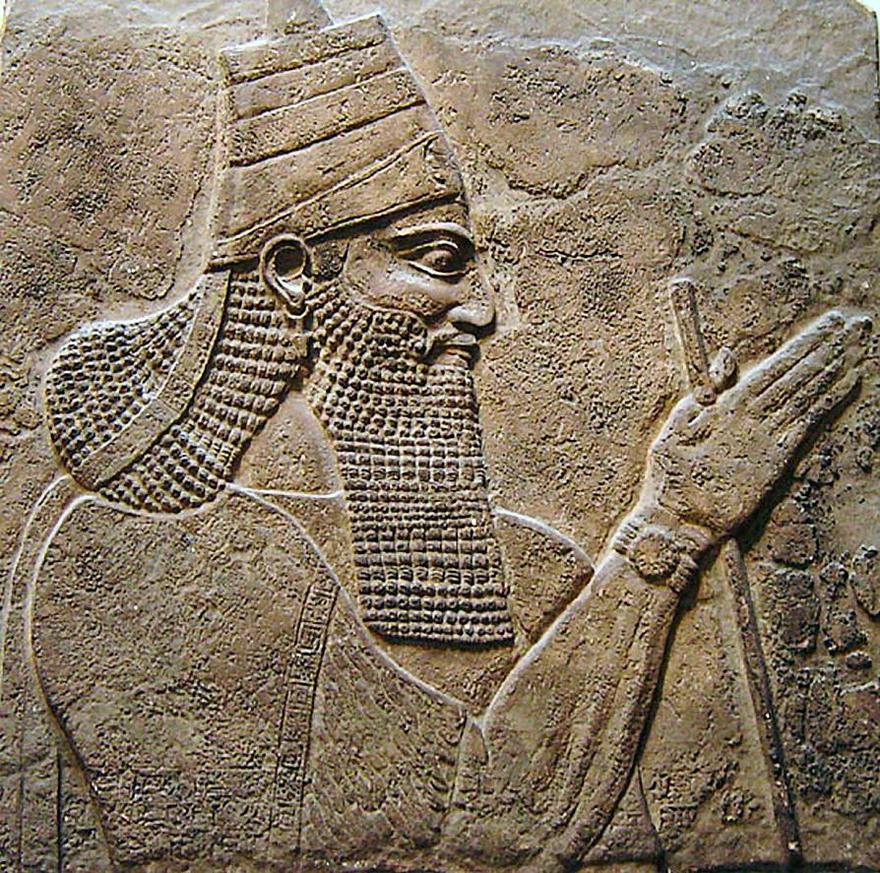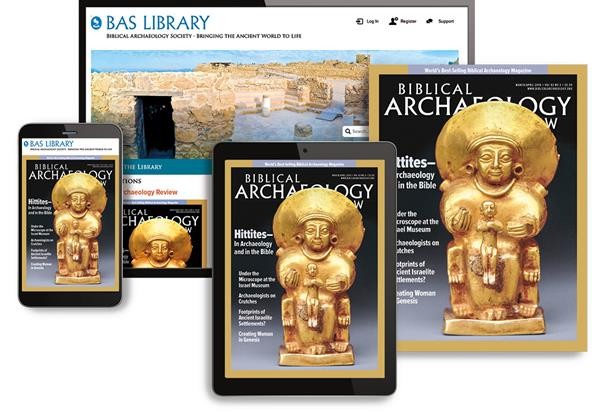 |
|
|
83 Real Bible PeopleMore than faith is required to confirm that people mentioned in the Bible were, indeed, real people How many people in the Bible can actually be confirmed to have existed? How can we separate men and women mentioned in the Bible from myth and metaphor? These are key questions for those who want to understand the world of the Bible from an objective, academic point of view. Our BAS Library Collection 83 Real Bible People details the process of verifying these people. Renowned biblical scholar Lawrence Mykytiuk takes us deep into the world of the Hebrew Bible and New Testament through an impartial lens of archaeological and historical confirmation in this Collection. One of the popular features in each issue of Biblical Archaeology Review is one that asks, “How Many?” This BAS Library Collection answers that question in splendid detail. The first article in the Collection presents a meticulous timeline of pharaohs, kings, high priests—and one assassin—in Archaeology Confirms 50 Real People in the Bible. We read about King David—who, according to the Bible, ruled in the tenth century B.C.E. But for decades, maybe longer, some scholars have doubted his existence. Man or myth? You may be surprised to find out how relatively recently this question has been resolved. Hezekiah, another Judahite king, is credited with building the tunnel that kept Jerusalem supplied with water to withstand the siege of the city by the Assyrian ruler Sennacherib. How do we know that Hezekiah was a real king? One of his enemies told us. See how biblical passages mentioning these well-known figures stand up under the light of archaeological scrutiny. Mykytiuk explains how he avoids the trap of circular reasoning to verify the existence of people in the Bible, and why that is a key to diligent research. Travel the timeline of the biblical record back to the reign of Babylonian monarch Nebuchadnezzar, who destroyed Solomon’s Temple in 586 B.C.E. and exiled the Jews to Babylonia. We’ve read about this event; there are poems and songs dedicated to the story. See how we know that this Babylonian monarch and many others were real. Learn about the Cyrus Cylinder that documents the freeing of the Jews from Babylonian exile and compare the archaeological evidence to the account of the proclamation at the end of the Hebrew Bible. Archaeology Confirms 50 Real People in the Bible brings Bible passages to life in a verifiable way that puts these people and the events around them into a clearer historical perspective. Mykytiuk’s methodical approach to this verification process requires three points of corroboration in order to consider the verification to be accurate. Learn about his exacting approach to making conservative, confident identifications. The first article focuses on people in the Hebrew Bible. Mykytiuk also explores people in the New Testament by addressing the key question first, in the next article in our Collection. In Did Jesus Exist? Searching for Evidence Beyond the Bible, Mykytiuk explores this question, and the rationale for relying on particular sources to answer it. |
|
| Biblical evidence of the existence of Jesus is, of course, somewhat muddled because of its theological foundation. So, while there is obviously ample reference to Jesus in the New Testament, researchers look to more objective documentation in the form of classical and Jewish writings that speak of Jesus, his followers, and his brother James.
Read how the work of Roman senator and historian Tacitus corroborates biblical accounts of Jesus’ death in his final major work entitled Annals. Learn about the linguistic details that make a strong case for the veracity and validity of this document. Another work that speaks of Jesus as a real person comes from Josephus—a controversial Jewish priest who witnessed the destruction of the Temple in Jerusalem in 70 C.E., became a prisoner of war, and ultimately accepted the patronage of two Roman emperors. Many of his fellow Jews were appalled. Josephus asserted his strong support of and pride in Judaism, even as he toiled in imperial Rome to create his historical works. His chronicling of events presents straightforward references to Jesus that put this great historical figure into everyday context. You’ll appreciate how independent sources help confirm what we can read in the Gospels: that Jesus was real. You can also read how others of the time period perceived Jesus and his followers, and the clues in some writings that indicate later modification by other, less objective, authors—and how researchers can identify and decipher these clues. As we continue through our Collection, we can appreciate the depth and breadth of biblical research, and celebrate each new discovery. Mykytiuk’s article Archaeology Confirms 3 More People in the Bible verifies that three more biblical figures were, in fact, actual people. Read about the confirmation of a Persian governor and two high officials in the court of Nebuchadnezzar II—the king of Babylon who destroyed the first Temple in Jerusalem in 586 B.C.E. It takes somewhat more research to ascertain the identity of religious figures in the New Testament—unlike kings, emperors, or other political figures, religious figures did not erect monuments to themselves nor mint coins to flaunt their wealth. In New Testament Religious Figures Confirmed, Mykytiuk cites non-Christian sources to confirm the identity of several religious figures who play a prominent role in the New Testament. Among those religious figures to earn positive identification is a rabbi who makes a dramatic appearance in the New Testament: Gamaliel the Elder, grandson of the great Jewish leader Hillel. According to a passage in Acts 5 of the New Testament, apostles Peter and John had been summoned before the Jerusalem Sanhedrin, where the elders of Israel ordered the two men to stop proclaiming their message on the steps of the Temple. Every time they were told to stop, they started up again. Gamaliel the Elder addressed the Sanhedrin, advising them to leave Peter and John alone. This account corroborates independently verifiable facts about Gamaliel found in several tractates of the Mishnah and also in the writings of Jewish historian Josephus. Josephus also chronicles the demise of John the Baptist in his work Antiquities. Josephus says John was an innocent man who fell victim to a ruler who feared his influence. Josephus refers to John as “the Baptist” but does not mention John’s connection to Jesus, yet it is clear from Josephus’ writings that this is the same John described in the Gospels. Josephus also mentions Jesus’ brother James in an objective way that leaves little doubt of the man’s identity. |
|
| A combination of archaeological discoveries and contemporaneous writings also validates several high priests who served in Jerusalem. The goal of the priesthood was to mediate between the Jewish populace and the Roman governors to avoid Roman retaliation—an effort that ultimately failed in 70 C.E. with the destruction of the Second Temple.
It takes meticulous examination of archaeological evidence and a deep understanding of biblical and extra-biblical writings to unravel the mysteries of who’s real and who’s not in the Hebrew Bible and the New Testament. This is as true of political figures as it is of religious figures. In New Testament Political Figures Confirmed, Lawrence Mykytiuk turns to extra-biblical inscriptions and ancient writings to validate some of the political players found in the New Testament. By putting the political landscape of the time into clearer focus, Mykytiuk introduces us to the Herodian family of rulers that had great influence on the lives—and deaths—of significant people in the New Testament, including John the Baptist, Paul the Apostle, and, of course, Jesus. Close examination of historical records and archaeological artifacts put events of Jesus’ time into clear relief. Mykytiuk paints a vivid picture of some of the machinations at work at the time, and examines the discovery of a humble artifact that clearly identifies Pontius Pilate. In all, Mykytiuk confirms the identity of 23 political figures prominent in the New Testament. A detailed chart accompanies the article, listing their names and the manner in which their identities have been confirmed. 83 Real Bible People brings Biblical history to life Lawrence Mykytiuk provides thoughtful, well-researched detail to each of his focused articles. In addition, he supplements these articles with a complete list of endnotes with details of the archaeological evidence identifying each Biblical figure. This thorough, in-depth research is what readers of the Biblical Archaeology Society have come to expect. And you can read articles like this and hundreds more when you unlock the BAS Library. In 83 Real Bible People, BAS editors have carefully compiled a special collection of articles from Biblical Archaeology Review that explore many of the biblical personalities from both the Hebrew Bible and the New Testament. You’ll want to read all of the articles included in this collection—all written by renowned biblical scholar Lawrence Mykytiuk:
|
|
| Get instant access to an entire Library of content about the people, places, and events in the Bible—when you sign up for an All-Access Membership today for just 99¢ a month!
There’s a great deal more to explore in the BAS Library when you sign up today. From the Dead Sea Scrolls to Yahweh's wives and the Canonical Gospels, the BAS Library includes thousands of searchable articles, photos, videos, maps, and other resources for the discerning Bible scholar and the everyday Bible history enthusiast. In the BAS Library, you’ll learn new details about Biblical archaeology—every day—because the scholarship is constantly evolving as new discoveries are uncovered and rare artifacts are revealed. The BAS Library includes online access to more than 9,000 articles by world-renowned experts and 22,000 gorgeous color photos from…
Plus, you get access to so much more with your All-Access pass: Biblical Archaeology Review print edition: Enjoy new, upcoming issues in glorious, traditional, full-color print …
Biblical Archaeology Review tablet edition: Stay on top of the latest research! You get …
Special Collections: Carefully curated and topic-specific, BAS Special Collections give you all the content we have about certain topics and allow you to explore those topics in great detail. Popular Special Collections include:
And all of this rich and detailed scholarship is available to you—right now—by buying a special All-Access pass for ONLY 99¢ a month! |
|
| That’s right: when you purchase your All-Access pass, you get a ticket to four decades of study, insight and discovery. Why not join us right now and start your own exploration?
Whether you’re researching a paper, preparing a sermon, deepening your understanding of Scripture or history, or simply marveling at the complexity of the Bible – the most important book in history—the BAS All-Access pass is an invaluable tool that cannot be matched anywhere else. You'll get to experience all the discoveries and debate in beautiful clarity with Biblical Archaeology Review, anytime, anywhere! And the Library is fully searchable by topic, author, title and keyword, as well as the Special Collections like 83 Real Bible People. |










